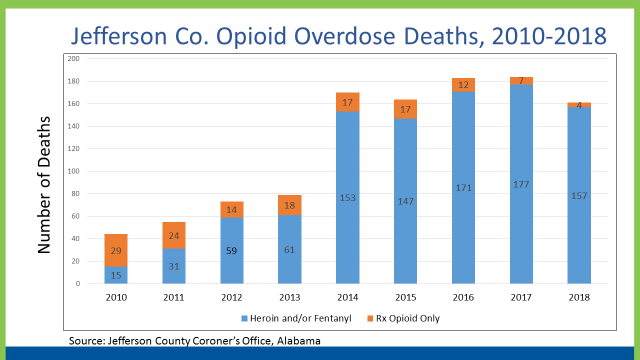UAB Launches Program to Improve Treatment of Opioid Overdose
UAB’s Emergency Department (ED) is starting a new program to better treat patients with opioid use disorder. The initiative, funded with $1.5 million from the U.S. Department of Health and Human Services, focuses on increasing the use of Medication Assisted Treatment Protocol (MAT). This treatment relies on a drug called Suboxone, which reduces withdrawal symptoms for patients recovering from an opioid overdose.
Dr. Erik Hess, vice chair for research in UAB’s Emergency Department, says Suboxone is a very effective treatment for opioid use disorder. But the drug is not used as often as it could be.
“The government has actually made it a requirement for eight hours of training for any provider who wants to provide a subscription for it (Suboxone),” Hess says, “which has set up a pretty substantial barrier for most providers.”
Hess says up until recently, only three ED doctors at UAB had completed this training. The goal now is to certify at least 75% of the department’s physicians to administer Suboxone.
Another focus of the program is to better connect patients with resources once they leave the ED. This involves a partnership with a local referral hub called the Recovery Resource Center at Cooper Green Mercy Health Services.
The Recovery Resource Center will send peer navigators, people who themselves are in long-term recovery, to meet with patients at the emergency department. Navigators will help patients transition out of the ED and find long-term treatment options.
UAB’s new program is funded for three years. During that time, officials expect to enroll more than 500 patients. They hope to see a 30% decrease in the number of deaths due to opioid overdose in Jefferson County. According to the Jefferson County Department of Health, 161 people died from an opioid overdose in 2018.
Musk forms new party after split with Trump over tax and spending bill
Musk said he's carrying out his threat to form a new political party after a falling out with Trump over the president's sweeping tax cuts law.
Knives, bullets and thieves: the quest for food in Gaza
NPR's Gaza producer faced Israeli military fire, private U.S. contractors pointing laser beams at his forehead and masked thieves as he tried to get food from a U.S.-supported group.
4 things to know about the vaccine ingredient thimerosal
Advisers to the Centers for Disease Control and Prevention recommended against flu shots containing the ingredient thimerosal. Why is the additive, safely used since the 1930s, being questioned again?
Tropical Storm Chantal strengthens slightly as it nears landfall in South Carolina
Tropical Storm Chantal grew in strength as it approached the southeast U.S. coast. It's forecasted to bring heavy rains to parts of the Carolinas on Sunday.
Dalai Lama, a global symbol of Tibetan culture and resistance, turns 90
The Dalai Lama turned 90 on Sunday surrounded by thousands of followers, who thronged the Himalayan town of Dharamshala.
Iran’s supreme leader makes first public appearance since Iran-Israel war started
Iran' s Supreme Leader Ayatollah Ali Khamenei on Saturday made his first public appearance since the 12-day war between Israel and Iran began, attending a mourning ceremony on the eve of Ashoura.









